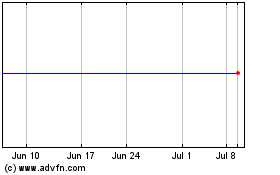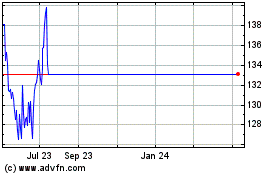Stock Market News for April 1, 2011 - Market News
April 01 2011 - 5:07AM
Zacks
Markets marked one of the strongest quarters of
the decade with negligible movement in the indices as investors
patiently await the job data from the Labor Department, scheduled
for Friday. The indices faced a stiff challenge from global issues
but survived the concerns to remain upbeat.
The Dow Jones Industrial Average (DJIA) gained
the most among the benchmarks over the quarter, jumping 6.4%.
The Standard & Poor 500 and Nasdaq followed the Dow,
gaining 5.4% and 4.8%, respectively. The Dow was also the best
performer for the month of March posting a gain of 0.8% while the
S&P 500 and Nasdaq dropped by 0.1% and 0.04%, respectively. For
the day, the Dow and S&P 500 slid 0.3% and 0.2% while the
Nasdaq gained 0.2%. The trend of low volumes continued on the New
York Stock Exchange, AMEX and Nasdaq with consolidated volumes
touching 6.9 billion shares, well below last year’s daily average
of 8.47 billion. The CBOE Volatility Index (VIX) remained almost
flat and was below 18.
The quarter’s performance is particularly
significant as it comes at a time of several challenges arising out
of global geopolitical tensions. Just when the indices returned a
sunny picture, with the Dow touching the psychological 12,000 mark,
the markets were jolted starting February 18 due to violence in
Libya. Violence in Libya intensified with rebels protesting against
their leader Muammar Gaddafi, who in return vowed to fight till the
end. Tension in Libya, a nation, which previously accounted for 2%
of the global daily crude output, propelled crude prices to a 2.5-
year high. Inflated crude prices have taken a toll on domestic
consumers and the global economy alike. Fed officials commented on
how the situation might turn for the worse globally and economists
are concerned over the possibilities of crude prices touching $200
per barrel if the unrest spreads to Saudi Arabia.
Next in line to add to the woes was the massive
earthquake and tsunami in Japan. The natural disaster damaged the
markets and indices were shaken further by the ensuing Japanese
nuclear crisis. Euro-zone debt woes also played a cameo as Portugal
inches closer to seeking an international bailout package. However,
positive economic data released amidst the tension factored in to
help the indices regain some ground and the markets have turned in
a strong quarterly performance.
A lot is at stake at the moment for the bourses
as the economy awaits employment data from the Labor Department.
Depending on the nature of these reports, the indices are likely to
run either climb up or drop down. On Wednesday, Automatic Data
Processing (ADP) had reported a considerable increase in private
payrolls. The report said 201,000 new jobs had been created in the
private sector over the month of March, in line with economists’
expectations. However, on several occasions in the past the ADP
report has not matched the government’s job data.
New applications for weekly jobless claims fell
less than expected, by 6000 to seasonally-adjusted 388,000 in the
week ended March 26. Economists had expected initial claims to fall
to around 380,000. However, this decline comes after claims for the
previous week were revised up to 394,000 from the originally
reported 382,000. The four-week average for weekly claims,
considered to be a more accurate measure, rose by 3,250 to
394,250.
In another report, factory orders were down
by 0.1% or $0.4 billion, to $446.0 billion in February contrary to
expectations of an increase by 0.5%, following a 3.3% increase in
January. Factory Orders are down following three consecutive
monthly increases. Excluding transportation, Factory Orders
increased by 0.1%.
On a sectoral basis, the retail and the
technology sectors weighed on the broader market. Retailers were
one of the worst performers on Thursday with the S&P Retail
index dropping 0.8%. CarMax Inc. (NYSE:KMX) led the fall after
dropping 7.2%. Among other retail shares, J. C. Penney Company,
Inc. (NYSE:JCP), Best Buy Co. Inc. (NYSE:BBY), Lowe's Companies
Inc. (NYSE:LOW) and RadioShack Corp. (NYSE:RSH) dropped 2.0%, 1.7%,
2.0% and 2.4%, respectively.
The slide in the technology sector was led by
Intel Corporation (NASDAQ:INTC) after an analyst lowered the
company’s target price citing a “downtick” in PC demand. The
company’s shares dropped 1.4% and settled at $20.18. Among other
tech stocks, Dell Inc. (NASDAQ:DELL), Cisco Systems, Inc.
(NASDAQ:CSCO), Microsoft Corporation (NASDAQ:MSFT), Broadcom Corp.
(NASDAQ:BRCM) and LSI Corporation (NYSE:LSI) shed 0.9%, 1.0%, 0.9%,
2.5% and 0.9%, respectively. Gainers for the sector included Google
Inc. (NASDAQ:GOOG), Oracle Corp. (NASDAQ:ORCL) and Autodesk, Inc.
(NASDAQ:ADSK) which rose 0.9%, 1.2% and 1.2%,
respectively.
AUTODESK INC (ADSK): Free Stock Analysis Report
BEST BUY (BBY): Free Stock Analysis Report
BROADCOM CORP-A (BRCM): Free Stock Analysis Report
CISCO SYSTEMS (CSCO): Free Stock Analysis Report
DELL INC (DELL): Free Stock Analysis Report
GOOGLE INC-CL A (GOOG): Free Stock Analysis Report
INTEL CORP (INTC): Free Stock Analysis Report
PENNEY (JC) INC (JCP): Free Stock Analysis Report
CARMAX GP (CC) (KMX): Free Stock Analysis Report
LOWES COS (LOW): Free Stock Analysis Report
LSI CORP (LSI): Free Stock Analysis Report
MICROSOFT CORP (MSFT): Free Stock Analysis Report
ORACLE CORP (ORCL): Free Stock Analysis Report
RADIOSHACK CORP (RSH): Free Stock Analysis Report
Zacks Investment Research
Life Storage (NYSE:LSI)
Historical Stock Chart
From May 2024 to Jun 2024

Life Storage (NYSE:LSI)
Historical Stock Chart
From Jun 2023 to Jun 2024
